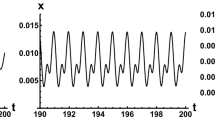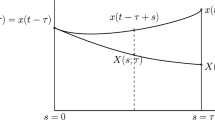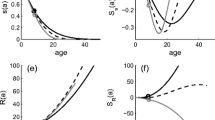Summary
A scalar integrodifferential equation is considered which describes a single self-regulating species. Three results are presented towards showing that the ‘carrying capacity’ equilibrium state becomes unstable as the self-regulating mechanism acts after a longer time lag.
Similar content being viewed by others
References
Ahlfors, L. V.: Complex Analysis, 2nd Edition, New York: McGraw-Hill (1953)
Cushing, J. M.: Periodic solutions of Volterra's population equation with hereditary effects, Siam J. Applied Math., Vol. 31, No. 2, September, 1976
Hadeler, K. P.: On the stability of the stationary state of a population growth equation with time-lag, J. Math. Biology 3, 197–201 (1976)
May, R. M.: Stability and Complexity in Model Ecosystems, Princeton: University Press (1973)
Walther, H. O.: On a transcendental equation in the stability analysis of a population growth model, J. Math. Biology 3, 187–195 (1976)
Author information
Authors and Affiliations
Rights and permissions
About this article
Cite this article
Stech, H.W. The effect of time lags on the stability of the equilibrium state of a population growth equation. J. Math. Biology 5, 115–120 (1978). https://doi.org/10.1007/BF00275894
Received:
Issue Date:
DOI: https://doi.org/10.1007/BF00275894




